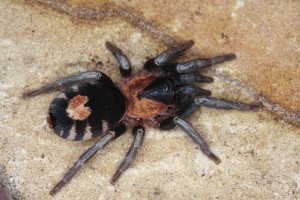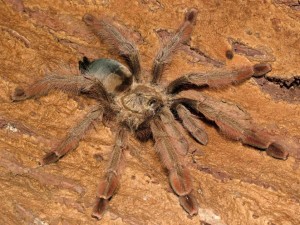Trinidad Dwarf Tiger Tarantula (Cyriocosmus elegans)
Cyriocosmus, New World 5 Comments »The Trinidad Dwarf Tiger Tarantula is a species native of Trinidad and Tobago and certain parts of Venezuela. This is a very small species and mature most times within a year with tarantulas only tending to be between 2 to 3 inches in length. They are hardy but have a shorter life span then most other species. This is a well loved species and definitely a great pet for any collection.
Habitat:
Being that they are very small tarantulas you will not need much to house them. As spiderlings they can easily be kept in pill vials filled half with substrate. As full grown adults they will not require more then a 2.5 gallon enclosure. They are obligate burrowers so make sure you have plenty of substrate for them to do so. Your substrate should be damp but not too wet. For this we recommend coconut fiber substrate. A hide can be added such as a piece of bark as a start up for their burrowing. They are most of the time underground but are very active once above ground. As always you should always have a fresh water dish readily available. We recommend a temperature of 77 to 83 degrees with a humidity level of about 75 percent.
Feeding:
Don’t let size fool you, these animals can take down same sized prey with ease. They are insectivores and so you want to make sure you feed them appropriately. We recommend you feed them flightless fruit flies as slings and slowly upgrade to small pinhead crickets to eventually large pinhead crickets and even b.dubia cockroaches. Feeding should be done once a week and should your tarantula not eat its prey within 24 hours remove the prey from its enclosure. It could be that he/she is in pre-molt stages and you will want to make sure you do not stress him/her out.
Attitude:
The Trinidad Dwarf Tiger Tarantula is very fast. Though they are mostly docile we recommend you not handling them due to their speed. They come equipped with urticating hairs and though they might not be known for biting it does not mean they do not bite should they feel threatened. Their bite is equivalent to a bee sting and their venom harmless to humans.
All in all we recommend the Trinidad Dwarf Tiger Tarantula as a great new world tarantula for an intermediate to expert keeper. Due to its speed we do not recommend this for a novice hobbyist. It is a great tarantula for any collection.
Tell us about your C. elegans we’d love to hear from you! Comment down below!




